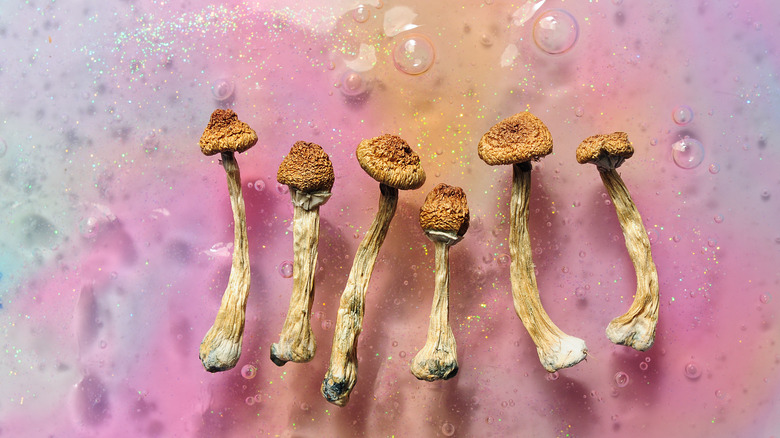What Is Psychedelic-Assisted Therapy?
When you think of psychedelics, you may conjure up the image of someone hallucinating with bright colors and fantastical creatures dancing across their periphery, often at a music festival or party. But psychedelics aren't always synonymous with a colorful drug trip. In recent years, the use of psychedelics has been proven effective in therapeutic settings. Psychedelic-assisted therapy, also called psychedelic therapy and hallucinogenic therapy, is a process of utilizing psychedelic substances to aid in therapeutic processes. (via Verywell Mind).
The practice of using psychedelic substances in therapeutic treatments was popular for several decades until the Controlled Substances Act was enacted in 1970 (per USC Environmental Health and Safety). In recent years, the practice of utilizing psychedelics to treat diagnoses from post-traumatic stress disorder (PTSD) to chronic pain has begun to be explored again by mental health professionals and scientific researchers, according to Healthline. There are several types of psychedelic substances that are used in psychedelic-assisted therapy, as well as multiple ways to administer the therapeutic process. Here is what you should know when it comes to psychedelic-assisted therapy.
How psychedelic-assisted therapy works
Microdosing may be the most popular form of administering psychedelic-assisted therapy. When it comes to microdosing, patients take a small amount of a psychedelic, usually 5% to 10% of a normal dose, according to The New York Times. Microdosing has been shown to be effective in increasing energy, focus, and concentration. It can also be a useful practice for reducing pain and alleviating symptoms from anxiety, stress, and depression (via Verywell Mind). However, legal microdosing depends on the type of psychedelic and where you are located. It is always important to check your local laws when it comes to taking psychedelics in any amount.
Psychedelic substances have been found to be most effective when combined with other forms of therapy, especially talk therapy, reports WebMD. Most psychedelic-assisted therapeutic treatment involves three states: consultation, ingestion, and integration (per Healthline). During the consultation phase, your provider will determine if psychedelic-assisted therapy is an appropriate treatment option for you. The ingestion period is when the psychedelic substance is consumed, and your provider will help supervise and guide you through your experience to ensure you feel safe. The integration phase is meant to prolong and incorporate any learnings or revelations you experienced during the psychedelic session and includes talk therapy between you and your provider (via California Center for Psychedelic Therapy). Since studies are ongoing to determine the most accurate administration of psychedelic-assisted therapy, the dosage amount and methodologies in treatment may vary.
Types of psychedelic-assisted therapy
The most common types of psychedelic-assisted therapy include psilocybin, LSD, ayahuasca, and MDMA. Psilocybin, also known as magic mushrooms, is a hallucinogenic that can result in changes in mood, thought, and perception (per Alchohol and Drug Foundation). In recent years, psilocybin has been found to be effective in the treatment of depression. Lysergic acid diethylamide, better known as LSD, is an odorless substance that is typically white or clear in color, and it is considered to be one of the most powerful of mind-altering psychedelics. Ayahuasca is a drinkable liquid that is brewed from leaves, and it is believed to help with depression, anxiety, and addiction (via Healthline).
MDMA, also known as ecstasy, isn't technically a psychedelic but it does cause changes in perception and memory. MDMA is more similar to amphetamines, or stimulants, and creates an altered consciousness that lasts between three and six hours, according to the National Institute on Drug Abuse. Like psychedelics, it is possible to overdose on MDMA and experience adverse health effects including organ failure and even death. When engaging in psychedelic-assisted therapy, it is always important to do so under the supervision of a trained professional and to be mindful of the effects on your body.
If you or anyone you know is struggling with addiction issues, help is available. Visit the Substance Abuse and Mental Health Services Administration website or contact SAMHSA's National Helpline at 1-800-662-HELP (4357).
The effectiveness of psychedelics in therapy
How effective is psychedelic-assisted therapy? A 2020 meta-analysis in the Journal of Psychoactive Drugs looked at the overall effect of psychedelic-assisted therapy compared to placebos across nine studies. The analysis found that psychedelic-assisted therapy is effective in treating post-traumatic stress disorder, anxiety or depression when dealing with a life-threatening illness, and social anxiety for adults living with autism.
However, many of the clinical trials on psychedelic-assisted therapy have emphasized high doses of psychedelics for improving mental health. A 2019 study in Frontiers in Psychiatry asked more than 400 people about how effective lower doses of psychedelics, called microdosing, were compared to conventional treatments. The study found that more people believed microdosing of psychedelics worked because it made their symptoms disappear and improved their quality of life versus conventional treatments for their mental and physiological disorders. Experts also found that regular doses of psychedelics were more effective than microdosing for mental disorders, particularly depression and anxiety.




